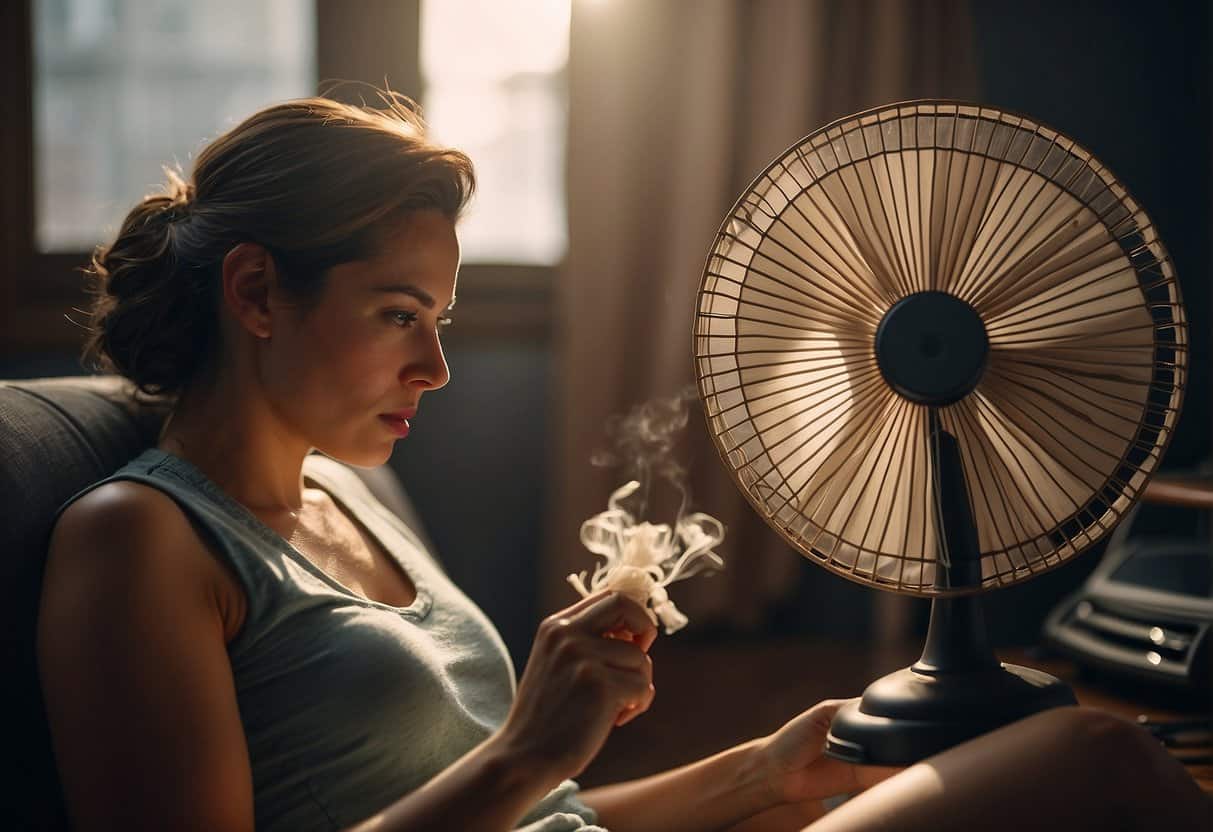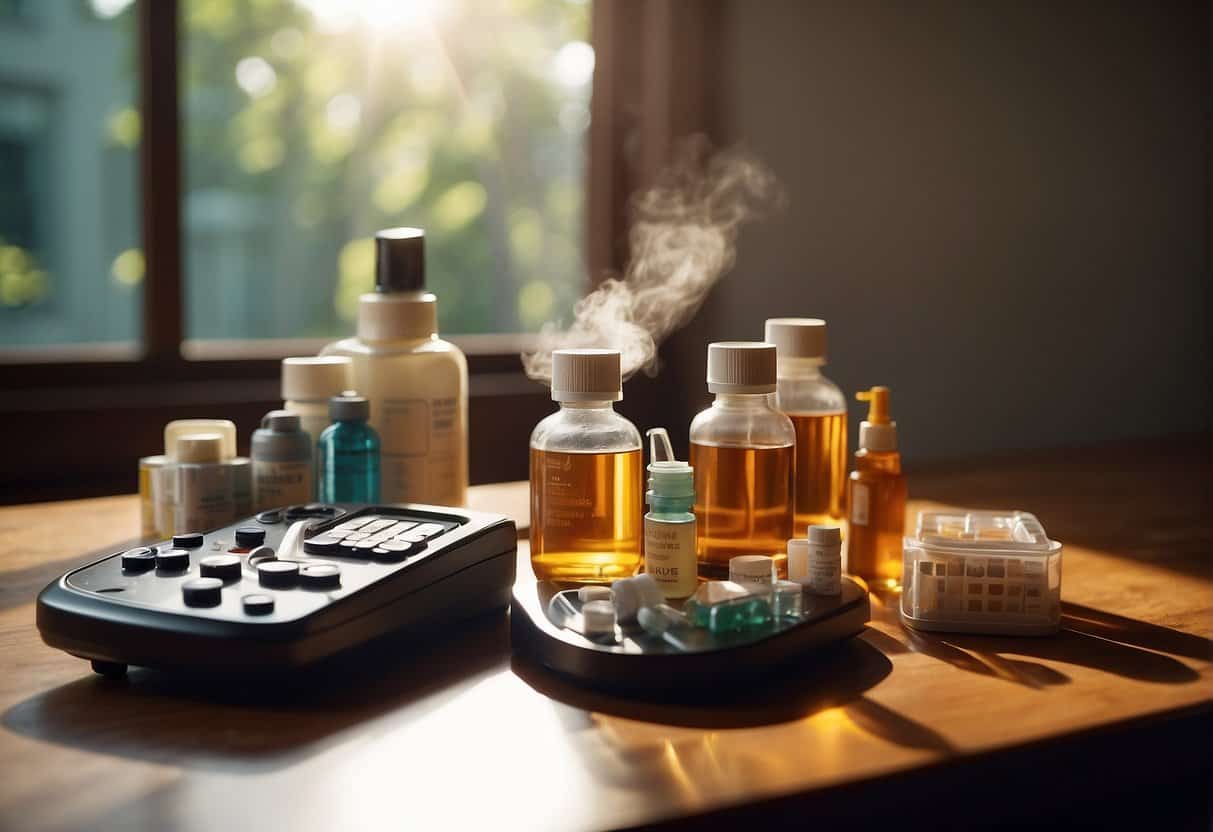Hot flashes are a common physiological response experienced by many women, particularly during the menopausal transition. Characterized by a sudden sensation of heat that seems to emanate from within and spread throughout the upper body, hot flashes can also be accompanied by reddening of the skin, sweating, and, occasionally, heart palpitations. They are indicative of the complex hormonal changes occurring in a woman’s body, reflecting the intricate relationship between hormone levels and the body’s internal thermostat.
While the exact cause of hot flashes is not entirely understood, they are most closely associated with the decrease in estrogen that characterizes menopause. However, they can also be prompted by certain lifestyle factors and health conditions, not merely hormonal shifts. The experience of a hot flash can vary greatly from person to person in both frequency and severity, impacting daily life and overall comfort.
Key Takeaways
- Hot flashes are sudden, intense sensations of heat, primarily affecting women in menopause.
- They result from hormonal changes but can also be influenced by lifestyle and health factors.
- Managing hot flashes involves a combination of medical and lifestyle approaches.
Understanding Hot Flashes
Hot flashes are a common and often disruptive symptom experienced primarily by women going through menopause. We will explore the key aspects of hot flashes including their definition, physiological underpinnings, prevalence, and differentiation from related symptoms like night sweats.
Definition and Description
Hot flashes refer to sudden episodes of intense warmth that are not caused by external temperatures. They can affect the face, neck, chest, and other parts of the upper body. During a hot flash, you may also experience redness of the skin (flushing), sweating, and a tingling sensation.
Physiological Mechanism
Physiologically, hot flashes are vasomotor symptoms originating from the brain’s response to changes in hormone levels, notably estrogen. These changes interfere with the body’s temperature regulation, prompting the skin to release heat. This leads to the sudden sensation of warmth and subsequent sweating as the body attempts to cool down.
Prevalence and Onset Age
Hot flashes are most prevalent among women who are in the menopausal transition, typically occurring between the ages of 40 and 58. However, they can also affect women before and after this age range due to various hormonal fluctuations or medical conditions.
Differentiating Hot Flashes and Night Sweats
While often lumped together, hot flashes and night sweats are distinct. Night sweats happen specifically during sleep and are severe hot flashes that result in intense sweating enough to drench sleepwear. Hot flashes occur during waking hours and can vary in frequency and severity. Both are considered vasomotor symptoms, with night sweats essentially being nocturnal hot flashes.
Causes and Triggers

Hot flashes are primarily caused by changes in hormone levels and can be exacerbated by various lifestyle and environmental factors. We’ll explore the significance of hormonal changes, specifically the role of estrogen in menopause, and identify common triggers that may induce hot flashes.
Hormonal Changes and Estrogen Levels
Menopause is a key time in a woman’s life where hormonal fluctuations occur, predominantly in estrogen levels. It’s these changes in estrogen that often lead to vasomotor symptoms, commonly known as hot flashes. As estrogen levels decrease, it can affect the body’s temperature control, resulting in the sudden warmth and sweating characteristic of a hot flash.
Lifestyle and Environmental Triggers
Our environment and lifestyle choices can act as triggers for hot flashes. Factors such as diet, stress levels, heat exposure, and clothing choices play a significant role. For instance:
- Alcohol and caffeine: Consuming these substances can often provoke hot flashes.
- Spicy foods: This type of diet may act as a trigger for some individuals.
- Stress: Emotional stress is a known trigger for hot flashes.
- Smoking: Tobacco use has been linked to increased occurrence of hot flashes.
Environmental aspects like hot weather, or being in a hot room, can also initiate a hot flash. Additionally, wearing tight clothing that restricts airflow can contribute to the sensation of overheating.
Our awareness of these hormonal changes and lifestyle factors can help manage and mitigate hot flashes. Understanding these elements empowers us to take proactive steps in our health and wellness journeys.
Health and Risk Factors
In focusing on health and risk factors for hot flashes, we’ll examine both associated medical conditions and how personal and demographic factors can influence their occurrence.
Associated Medical Conditions
Hot flashes can be a symptom associated with several medical conditions. Foremost, they are frequently connected to hormonal changes such as those occurring during menopause. Additionally, certain endocrine disorders, specifically those affecting the thyroid, can cause hot flashes due to hormone imbalance. Research suggests that women undergoing treatment for breast cancer may experience hot flashes, often as a side effect of hormone therapy. Meanwhile, although less common, hot flashes can sometimes signal systemic diseases, including some forms of cancer.
Personal and Demographic Factors
Our personal and demographic characteristics significantly affect our risk of experiencing hot flashes. Prevalent factors include:
- Age: Hot flashes increase as women approach menopause, typically between ages 45 and 55.
- Race: Studies have found that race plays a role, with African American women reporting hot flashes more frequently than women of other races.
- Obesity: There’s a notable correlation between higher body mass index (BMI) and the intensity of hot flashes, likely due to insulation provided by excess fat or hormonal variations related to body fat.
- Anxiety: Psychological factors, such as stress and anxiety, have been known to trigger hot flashes.
These risks don’t guarantee that one will experience hot flashes, but they do increase the likelihood and can impact their severity and frequency.
Treatment and Management
When combatting hot flashes, we consider various effective strategies that encompass both lifestyle modifications and medical interventions to manage symptoms.
Lifestyle Changes and Home Remedies
Our approach to easing hot flashes often begins with lifestyle changes and home remedies. We recommend regular exercise to help maintain a healthy weight and improve mood, both of which can mitigate the frequency of hot flashes. Incorporating soy and flaxseed into our diet can also be beneficial, as these foods contain phytoestrogens that may have a mild estrogen-like effect on the body. Additionally, creating a cool environment using a fan can offer immediate relief, and meditation has been found useful for stress reduction, which may indirectly reduce the occurrence of hot flashes.
Medical Treatments
In terms of medical treatments, hot flashes can be addressed with various medication options. Hormone replacement therapy (HRT) is considered when we need a more direct intervention to stabilize hormone levels. Moreover, antidepressants are often prescribed, providing relief for our symptoms. For individuals looking for non-hormonal options, prescription medication such as gabapentin or clonidine might be suggested. Additionally, we could explore supplements like black cohosh, which has been traditionally used for menopause symptoms, though we must always consult with a healthcare provider before starting any new treatment.
Pharmacological Options
When exploring treatments for hot flashes, we have two primary pharmacological avenues: prescription medications and over-the-counter supplements. Prescription options can be highly effective, but should be carefully considered for long-term use due to potential side effects. Over-the-counter supplements offer alternative choices, but they may have variable evidence supporting their efficacy.
Prescribed Medications
Prescription options include hormone therapy and non-hormonal medications. Hormone therapy involves the use of estrogen, sometimes in combination with progestin, especially if one has an intact uterus to reduce the risk of endometrial cancer. Estrogen therapy is widely recognized as the most effective treatment for relieving menopausal hot flashes.
Another class of prescription drugs is antidepressants. Selective serotonin reuptake inhibitors (SSRIs) such as paroxetine, which is FDA-approved, venlafaxine, fluoxetine, and escitalopram, have all been used to mitigate hot flashes. Additionally, gabapentin and clonidine are two other prescription medications known to provide relief, though they are generally considered off-label for this use.
Over-the-Counter Supplements
In terms of over-the-counter treatments, several supplements are purported to help with hot flashes. Isoflavones, compounds found in soy and red clover, are believed to have estrogen-like effects and may be beneficial. Products like evening primrose oil, black cohosh, and dong quai are commonly sought for symptom alleviation, although our understanding of their efficacy and safety is not as well-established as for FDA-approved treatments. It is crucial for patients to discuss the use of these supplements with a healthcare provider to consider potential interactions with other medications and assess the appropriateness of their use.
Consequences of Hot Flashes
Hot flashes, or vasomotor symptoms, can have a significant impact on various aspects of daily living. They can disrupt not only our sleep but also our overall quality of life, bringing about a range of psychological effects.
Impact on Quality of Life
We often underestimate the effect hot flashes can have on our daily functioning. The sudden onset of heat and sweating can be embarrassing and uncomfortable, leading us to avoid social situations or activities we once enjoyed. Our work performance can suffer as well, as concentration and comfort are compromised.
Sleep Disturbances
Hot flashes can greatly disrupt our sleep patterns. The abrupt feeling of warmth can cause us to wake frequently throughout the night, leaving us feeling tired the next day. The cycle of sweating and then feeling chilled can prevent us from getting the deep, restorative sleep we need.
Psychological Effects
The unpredictable nature of hot flashes can contribute to mood fluctuations and increased anxiety. We may feel a loss of control over our bodies, which can lead to frustration and even affect our mental health. The stress of managing these symptoms can exacerbate the psychological impact, making it a significant area of concern.
Alternative Therapies
In our exploration of managing hot flashes, we turn to alternative therapies that many women consider. These range from plant-based supplements to specific mind and body practices, aimed at reducing the frequency and severity of hot flashes without the use of hormone therapy.
Herbal and Plant-Based Remedies
Herbal remedies are a cornerstone in the non-hormonal treatment of hot flashes. Soy has been studied for its isoflavones, which can have estrogen-like effects in the body, potentially easing hot flashes for some women. However, it’s essential to approach soy supplementation cautiously as the results can vary based on an individual’s metabolism and the composition of gut bacteria.
- Black cohosh: A widely-known herb that might reduce hot flashes and improve sleep.
- Evening primrose oil: Contains gamma-linolenic acid (GLA) and may have a mild effect on hot flash relief.
It is crucial for us to note that the effectiveness of these remedies can be influenced by factors such as race and overall quality of life, and not all supplements are suitable for everyone. The safety of these products can also be a concern, as they are not regulated as strictly as conventional medications.
Mind and Body Practices
We embrace mind and body techniques that focus on the connection between our mental and physical health. These practices can help manage the stress response, which may in turn potentially lessen the intensity of hot flashes.
- Meditation and Hypnosis: These practices aim to calm the mind and can be effective in improving hot flash-related sleep disruption and mood changes.
- Acupuncture: This traditional Chinese medicine approach has been suggested to influence the hypothalamus, potentially reducing hot flash frequency and severity.
Regular exercise is also a key lifestyle change that can positively impact our overall well-being and might contribute to the reduction of hot flash symptoms. Together, these options can be considered as part of a comprehensive plan addressing menopause-related discomfort, always keeping in mind individual differences and consulting with a healthcare provider.
Preventive Measures and Tips
When we experience hot flashes, it’s clear our bodies are responding to internal changes. Fortunately, we can adopt certain strategies to help reduce their frequency and intensity.
Lifestyle Changes:
We can make a variety of lifestyle changes to help manage hot flashes. Regular exercise and stress management techniques such as meditation can improve our overall well-being and might reduce the severity of hot flashes.
- Clothing Choices:
- Opt for loose clothing to allow your skin to breathe.
- Layer outfits so we can adjust to our body temperature changes.
Cooling Strategies:
- Keep a fan or other cooling devices nearby, especially during sleep, to mitigate night sweats.
- Using cooling pillows or moisture-wicking bed linens can also offer relief.
Dietary Adjustments:
- We should aim to reduce the intake of known triggers like spicy foods, caffeine, and alcohol.
- Maintaining a balanced diet helps keep our hormone levels stable.
Mindfulness and Routine:
- Incorporating relaxation and breathing techniques can help in stress management.
- Establishing a cool, comfortable environment at home and work encourages a consistent routine that our bodies can adapt to.
By integrating these preventive measures and tips into our daily routine, we can navigate through the challenges of hot flashes with greater ease and comfort.
Research and Future Directions
As we explore the landscape of hot flashes treatment, it is evident that cutting-edge research is paving the way for new therapies. Our understanding continues to expand, particularly in the realms of hormone therapy and its alternatives. Below, we delve into the specifics of ongoing research and the clinical studies that shape our knowledge and drive innovation in this field.
Emerging Therapies
We are witnessing promising advancements in nonhormonal options for hot flash management. Selective serotonin reuptake inhibitors (SSRIs), traditionally used for depression, are now being repurposed to alleviate hot flashes, especially where hormone therapy is unsuitable. Additionally, the FDA has approved several non-SSRI medications, recognizing their benefits for those with medical conditions such as breast or prostate cancer, where hormone treatments are often contraindicated. Researchers are working diligently to identify future treatments, including those targeting novel neurological pathways involved in the body’s thermoregulatory process.
Clinical Studies and Trials
Clinical trials are crucial in validating the efficacy and safety of new hot flash remedies. These studies meticulously scrutinize various aspects, such as dosage, treatment duration, and potential side effects. The Mayo Clinic is among the key institutions actively conducting Hot Flashes Clinical Trials to explore alternative options to hormone therapy. Through rigorous clinical trials, we seek to better understand which treatments can enhance the quality of life for those experiencing hot flashes due to cancer treatments or other health conditions like HIV, diabetes, or infections.
Support and Resources
Navigating the complexities of hot flashes can be challenging, but we are not alone. Support groups and professional health organizations provide vital information and community assistance that can be invaluable during this time.
Discussion Groups and Forums
We can seek solace and shared experiences in discussion groups and forums. They are invaluable spaces for us to connect with others who are also experiencing vasomotor symptoms associated with menopause or perimenopause. Websites like Menopause Matters offer forums where we can discuss our experiences, treatments, and coping strategies for hot flashes.
- Online communities can offer:
- Personal stories and advice from others experiencing hot flashes
- Information on handling perimenopause, menopause, and related medical conditions
Professional Health Organizations
Professional health organizations provide us with a wealth of knowledge. The North American Menopause Society (NAMS) serves as a leading source for understanding menopause-related health issues. They provide evidence-based information and recommendations that guide us through any medical interventions we might be considering, such as hormone replacement therapy.
- Resources from health organizations include:
- Updated research on managing vasomotor symptoms
- Directories of healthcare professionals specializing in menopause, perimenopause, and conditions like endometrial cancer
By utilizing these support and resources, we empower ourselves with knowledge and community support to better manage our hot flashes and related health concerns.
Understanding Related Terminology
When discussing hot flashes, it’s essential to unpack terms often encountered in association with this phenomenon. Hot flashes, also known as vasomotor symptoms, are sudden feelings of intense heat predominantly in the upper body.
During menopause, the body undergoes significant hormonal changes. It’s a natural part of aging when a person’s estrogen levels decrease, leading to the cessation of menstruation. Perimenopause is the transitional phase leading up to menopause.
Hormone replacement therapy (HRT) is a treatment used to alleviate menopausal symptoms by supplementing hormones such as estrogen and progesterone. HRT can increase the risk of certain conditions like endometrial cancer, so it should be closely managed by healthcare providers.
Selective serotonin reuptake inhibitors (SSRIs) are a class of antidepressants that, aside from treating depression, can also relieve hot flashes. Prescription medications may also include other drug classes, depending on the individual’s health status and hormone levels.
| Term | Description |
|---|---|
| Hot Flash | Sudden warmth, often with redness and sweating |
| Menopause | End of menstrual cycles due to hormonal changes |
| Vasomotor Symptoms | Another term for hot flashes |
| Perimenopause | Transitional phase before menopause |
| Hormonal Changes | Shifts in hormone levels causing menopause |
| Progesterone | Hormone that regulates menstruation |
| Endometrial Cancer | Potential risk from hormone therapy |
| Hormone Therapy | Treats menopausal symptoms |
| Estrogen Levels | Hormone decrease causing menopause |
| SSRIs | Medication option for hot flash relief |
| Antidepressants | Can include other benefits, like hot flash relief |
| Prescription Medications | Could adjust hormone levels or provide symptom relief |
By familiarizing ourselves with these terms, we better understand the scope and impact of hot flashes and related treatments during menopause and perimenopause.
Navigating Menopause and Hot Flashes
As we approach or experience menopause, it’s crucial to understand that hot flashes are a common symptom caused by hormonal changes, particularly in estrogen levels. These can affect our quality of life, disrupt our daily activities, and may persist into the post-menopausal period.
Life After Menopause
Many of us find that life after menopause can be quite manageable once we get a handle on our symptoms. Hormonal changes continue, but the frequency of hot flashes may decrease over time. Understanding this can provide us relief, knowing there is a transition phase where our bodies are adjusting. Adaptable lifestyle changes and exploring various treatment options can play pivotal roles in maintaining a desirable quality of life.
Managing Symptoms in Daily Life
Managing hot flashes and their impact on our daily lives revolves around certain lifestyle changes and sometimes medication or therapy. We need to focus on:
-
Exercise: Regular physical activity is essential for managing weight and improving mood, which can help reduce hot flash frequency.
-
Stress Management: Techniques like meditation, deep breathing, or yoga can help alleviate symptoms, as stress is a known trigger for hot flashes.
-
Sleep: Aim for a cool, comfortable sleeping environment and a consistent routine to combat night sweats and improve sleep quality.
-
Diet: Avoid known hot flash triggers like spicy foods, caffeine, and alcohol. Incorporating foods that support our hormone levels might be beneficial.
If these methods aren’t enough, we may consider other treatment options such as hormone replacement therapy (HRT), after discussing with our healthcare provider about the risks and benefits specific to our health.
Glossary of Terms
- Menopause: The time in a woman’s life when we stop menstruating permanently, marking the end of our reproductive years.
- Hot Flash: A sudden feeling of warmth, often intense, usually affecting the face, neck, and chest, linked to our declining estrogen levels.
- Vasomotor Symptom: A broader category that includes hot flashes as well as other symptoms, such as sweating or palpitations, related to changes in our blood flow.
- Hormone Replacement Therapy (HRT): A treatment we may use to relieve symptoms of menopause. It replaces hormones like estrogen and progesterone, which decrease during menopause.
| Term | Description |
|---|---|
| Hysterectomy | A surgical procedure that removes our uterus, which may lead to menopause if our ovaries are removed. |
| Thyroid | A gland that produces hormones regulating our metabolism; its dysfunction can mimic menopausal symptoms. |
| Hormone Therapy | Another term for HRT, used to balance hormones in our body. |
| Night Sweats | Hot flashes that occur at night, potentially disrupting our sleep. |
- Age: Most of us experience menopause and its symptoms, including hot flashes, typically between 45 and 55 years of age.
- Race: Studies suggest that the experience of hot flashes may vary by race, with some racial groups reporting them more frequently.
- Supplements: Non-hormonal over-the-counter products we might use to alleviate menopausal symptoms, including isoflavones which are plant-based compounds with estrogen-like effects.
- Fan/Acupuncture: Lifestyle changes or alternative treatments we might consider to provide relief from hot flashes.
- Endometrial Cancer: A type of cancer affecting the lining of our uterus; hormone therapy can raise our risk, and so we should use it cautiously.
- SSRIs: A class of medications we sometimes use off-label to reduce the frequency and severity of hot flashes.
Frequently Asked Questions
In this section, we answer some of the most common questions surrounding hot flashes to provide clarity and guidance.
How can one effectively alleviate hot flashes?
To effectively alleviate hot flashes, we suggest lifestyle adjustments such as wearing light clothing, keeping the environment cool, and avoiding known triggers like spicy food and alcohol. For additional relief, certain treatments may be recommended by healthcare professionals.
Are hot flashes indicative of any serious health conditions?
Hot flashes are typically a normal symptom of perimenopause and menopause, but persistent hot flashes could sometimes be a sign of underlying issues. It’s important for us to consult a healthcare provider to rule out any serious health conditions.
What experiences are commonly associated with hot flashes during perimenopause?
During perimenopause, hot flashes often come with a sudden feeling of heat, sweating, and a red flush across the face and chest. Symptoms like night sweats may also disrupt our sleep.
Can younger individuals experience hot flashes, and if so, why?
Yes, younger individuals can experience hot flashes, often due to hormonal fluctuations, certain medications, or medical conditions. It’s crucial for us to seek medical advice if hot flashes occur outside of the typical age range for menopause.
What are the common triggers of hot flashes?
Common triggers of hot flashes include hot beverages, caffeine, alcohol, spicy foods, tight clothing, stress, and a warm environment. Identifying and avoiding our personal triggers can help reduce the frequency and severity of hot flashes.
What are some conditions that may be confused with hot flashes?
Conditions such as panic attacks, certain infections, and thyroid issues could mimic hot flashes. We must be vigilant and consult healthcare providers if the symptoms persist or are accompanied by other unusual symptoms or concerns.





